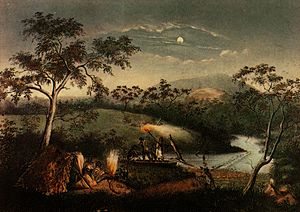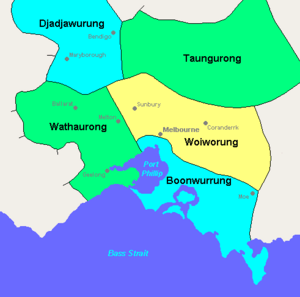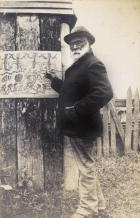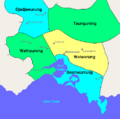Wurundjeri facts for kids
| Languages | |
|---|---|
| Woiwurrung language, English | |
| Religion | |
| Australian Aboriginal mythology, Christianity, Irreligion | |
| Related ethnic groups | |
| Boonwurrung, Dja Dja Wurrung, Taungurung, Wathaurong see List of Indigenous Australian group names |

The Wurundjeri people are an Aboriginal Australian group. They belong to the Woiwurrung language group and are part of the Kulin nation. They are the traditional owners of the Birrarung (Yarra River) Valley. This area covers much of what is now Narrm (Melbourne). The Wurundjeri people still live in this area and across Australia. Early European settlers called them the Yarra tribe.
In 1985, the Wurundjeri Tribe Land and Compensation Cultural Heritage Council was created by Wurundjeri people.
Contents
What Does the Name Wurundjeri Mean?
The name Wurundjeri comes from the Woiwurrung language. According to an early expert, Alfred William Howitt, Urunjeri refers to a type of eucalyptus tree. This tree is also known as the manna or white gum. It grows commonly along the Birrarung.
Some modern Wurundjeri stories say their name combines two words. Wurun means 'Manna Gum'. Djeri is a type of grub found in the tree. So, the name can mean "Witchetty Grub People".
Wurundjeri Language
Wurundjeri people speak Woiwurrung. This is a dialect of Kulin. The Kulin language is spoken by the five groups in the Kulin nation.
Wurundjeri Clans and Their Lands
The Wurundjeri people have several different clans. Each clan has its own territory.
- Wurundjeri balluk: Their land stretches from Mount Baw Baw to Healesville. It includes the northern parts of the Birrarung (Yarra River). It also goes to the eastern side of the Mirrangbamurn (Maribyrnong River) and up to Gisborne.
- Wurundjeri Willum: Their land includes Narrm (Melbourne). It goes up to the east side of the Maribyrnong River and its western branch. It also reaches Geboor (Mount Macedon). This clan's name comes from wilam, meaning 'camp' or 'shelter'.
- Marin balluk: This clan's land is on the western side of the Maribyrnong River. It is centered around Koorakoorakup (Sunbury) and the areas near Geboor (Mount Macedon). Their name means 'Maribyrnong River'.
- Gunung Willum balluk: Their land is next to Wurundjeri country on the west side of Geboor (Mount Macedon). It goes through to Balitgurrk (Bullengarook) and Munal (Daylesford). Their name means 'river shelter swamp'.
- Balluk Willum: This clan is from the Cranbourne area. Their name means 'swamp shelters'. It refers to a swamp that used to be in the area before it was drained.
- Ngaruk Willum: This clan is from the south side of Corhanwarrabul (the Dandenong Ranges).
- Kurung Jang baluk: This clan is from the Melton area. Their name comes from gurrong (canoe) and baluk (swamp).
Wurundjeri Country and Boundaries
A researcher named Norman Tindale estimated that Wurundjeri lands covered about 12,500 square kilometers (4,800 square miles). This area included the Yarra and Saltwater rivers around Melbourne. It stretched north to Mount Disappointment. To the northwest, it reached Macedon, Woodend, and Lancefield. The eastern borders went as far as Mount Baw Baw and Healesville. The southern borders were near Mordialloc, Warragul, and Moe.
The Wurundjeri-balluk and Wurundjeri-willam people lived in the area from the Yarra Valley/Yarra River to Heidelberg.
In June 2021, the borders between the lands of two traditional owner groups in greater Melbourne were agreed upon. These groups are the Wurundjeri and Boonwurrung. The Victorian Aboriginal Heritage Council helped draw up these new lines. The new border goes across the city from west to east. The CBD, Richmond, and Hawthorn are on Wurundjeri land. Albert Park, St Kilda, and Caulfield are on Bunurong land.
It was also agreed that Mount Cottrell would be managed together by both groups. This mountain was the site of a sad event in 1836. The two groups representing the Wurundjeri and Boonwurrung are the Bunurong Land Council Aboriginal Corporation and the Wurundjeri Woi Wurrung Cultural Heritage Aboriginal Corporation. However, some people still disagree about these borders. Some claim Wurundjeri land spreads much further west and south.
Wurundjeri History
When the first European settlers arrived, they saw a landscape that looked like a park. It had large areas of grassy plains with few forests. This was likely because Indigenous people regularly burned parts of the land. This helped grow many yam daisies (murnong). These yam roots and other plants were a main source of food. Wurundjeri campsites changed with the seasons, depending on the weather and where food was available. Many camps were near the Birrarung (Yarra River) and its smaller rivers.
The Wurundjeri and Gunung Willam Balug clans dug for a special rock called diorite. They found it at the Mount William stone axe quarry. This rock was used to make valuable greenstone axe heads. These axes were traded over a wide area, reaching as far as New South Wales and Adelaide. The quarry was a key part of a trading network for different Aboriginal nations in Victoria. It had been used for over 1,500 years and covered 18 hectares (44 acres). In February 2008, the site was added to the Australian National Heritage List. This was because of its important cultural and archaeological value.
European settlement on Wurundjeri lands began after a special ceremony. Wurundjeri leaders performed a tanderrum ceremony. This ceremony allowed outsiders to temporarily use the resources of the clan's lands. However, John Batman and other Europeans misunderstood this act. They thought it meant they now owned all Woiwurrong territory.
Within a few years, settlements grew around Pound Bend. Major Charles Newman settled at Mullum Mullum Creek in 1838. James Anderson settled on Beal Yallock (now Anderson's Creek) a year later. The Wurundjeri people resisted these actions. They took cattle and burned fields. They were skilled with rifles. One elder, Derrimut, later spoke about the changes:
You see…all this mine. All along here Derrimut's once. No matter now, me soon tumble down…Why me have no lubra? Why me have no piccaninny? You have all this place. No good have children, no good have lubra. Me tumble down and die very soon now.
Coranderrk Station
In 1863, the remaining Wurundjeri people were given permission to live at Coranderrk Station. This was near Healesville. They were moved there. Even though they asked many times, they were not given ownership of this land. Coranderrk was closed in 1924. Most of its residents were moved again to Lake Tyers in Gippsland. Only five people refused to leave their Country.
Wurundjeri People Today
All Wurundjeri people today are descendants of Bebejan. He was a Ngurungaeta (leader) of the Wurundjeri people. He was present at John Batman's "treaty" signing in 1835. His daughter was Annie Borate (Boorat), and her son was Robert Wandin (Wandoon).
Joy Murphy Wandin, a Wurundjeri elder, talks about why it's important to keep Wurundjeri culture alive:
In the recent past, Wurundjeri culture was undermined by people being forbidden to "talk culture" and language. Another loss was the loss of children taken from families. Now, some knowledge of the past must be found and collected from documents. By finding and doing this, Wurundjeri will bring their past to the present and recreate a place of belonging. A "keeping place" should be to keep things for future generations of our people, not a showcase for all, not a resource to earn dollars. I work towards maintaining the Wurundjeri culture for Wurundjeri people into the future.
In 1985, the Wurundjeri Tribe Land Compensation and Cultural Heritage Council was created. Its job is to follow laws about Aboriginal heritage. It also helps teach more people about Wurundjeri culture and history.
Wurundjeri elders often attend events where visitors are present. They give the traditional welcome to country greeting in the Woiwurrung language:
- Wominjeka yearmenn koondee-bik Wurundjeri-Ballak, which means, Welcome to the land of the Wurundjeri people.
Notable Wurundjeri People
Here are some important Wurundjeri leaders and people:
Ngurungaeta (Leaders):
- Bebejan (?-1836): A leader and father of William Barak.
- Billibellary (1799–1846): A leader of the Wurundjeri-willam clan.
- Simon Wonga (1824–1874): Became a leader by 1851 until his death. He was Billibellary's son.
- William Barak (1824–1903): A leader of the Wurundjeri-willam clan from 1874 until his death.
- James Wandin (1933–2006): A leader until his death. He was also an Australian rules football player.
- Murrundindi: Has been a leader since 2006.
Other notable Wurundjeri people include:
- Tullamareena: Was present during the founding of Melbourne.
- Derrimut (1810–1864): An elder linked to the Woiwurrung.
- Diane Kerr: An elder.
- Winnie Quagliotti (1931–1988): An elder.
- Joy Murphy Wandin: A senior elder.
Images for kids
See also
 In Spanish: Wurundjeri para niños
In Spanish: Wurundjeri para niños




